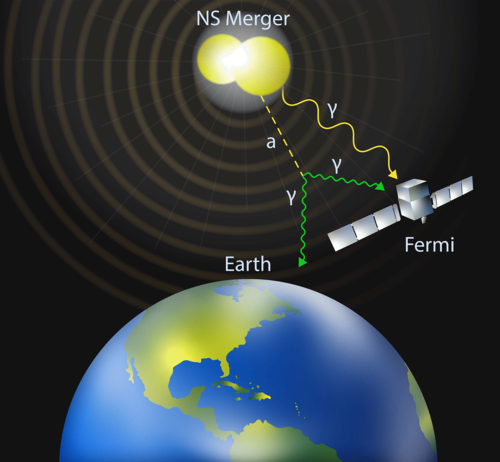Colliding neutron stars hint at new physics that could explain dark matter
"We have good reason to suspect that new physics beyond the standard model might be lurking just around the corner."

The collision of two neutron stars around 130 million light-years from Earth, and the unique physics this merger created, may have shed new light on dark matter.
New research conducted by Washington University physicist Bhupal Dev suggests the neutron star merger, detected here on Earth as the gravitational wave signal GW170817, could help place constraints on hypothetical particles called "axions," one of the leading candidates for dark matter.
Axions have never been directly detected, but they appear in many models that extend physics beyond the so-called Standard Model of particle physics, which is our current best description of subatomic particles and how they interact with each other.
Related: What happens when neutron stars collide? Astronomers may finally know
Dark matter is such a challenge for scientists because it doesn't interact with light, which means it is effectively invisible to our eyes. Dark matter also exhibits an apparent lack of interaction with other forces like the electromagnetic force. Overall, because of these strange features, dark matter can't be made up of electrons, protons and neutrons, the ingredients of normal matter that comprise stars, planets, our bodies and everything around us on a day-to-day basis.
This mystery is further compounded by the fact that the everyday stuff we are aware of and which is contained in the Standard Model accounts for just 15% of the total matter in the universe.
"We have good reason to suspect that new physics beyond the standard model might be lurking just around the corner," Dev said in a statement. "Extreme astrophysical environments, like neutron star mergers, provide a new window of opportunity in our quest for dark sector particles like axions, which might hold the key to understanding the missing 85% of all the matter in the universe."
Breaking space news, the latest updates on rocket launches, skywatching events and more!
Are axions hiding neutron star wreckage?
Neutron stars are born when massive stars exhaust their fuel supplies necessary for internal nuclear fusion and can no longer support themselves against the inward push of their own gravity. As this cosmic balancing act that has existed for millions of years ends, a star's outer layers are thrown away in a massive supernova explosion.
This leaves behind a collapsed stellar core with the mass of the sun crammed into a width of around 12 miles (20 kilometers). That's a neutron star, named as such because it's filled with neutron-rich matter. Neutron stars are so dense that if a teaspoon of it were scooped up and brought to Earth, it would weigh around 10 million tons. That's about 30 times as heavy as the Empire State Building.
These neutron stars don't always exist in isolation; sometimes, they swirl around a fellow neutron star companion. As these neutron stars orbit around each other in such a so-called neutron star binary, they create ripples in spacetime called gravitational waves. As these spacetime ripples radiate outward, they carry angular momentum away from the binary, causing its constituent stellar remnants to draw tighter together. This continues until the neutron stars' gravity takes over and causes them to slam together and merge.
Unsurprisingly, given the extreme nature of neutron stars, a collision between two such stellar remnants spurs tumultuous types of physics that aren't seen anywhere else in the universe. In fact, scientists already think neutron star mergers are the only environments violent enough to forge elements heavier than iron, like gold and silver, that even the boiling hearts of massive stars can't create.
This is possible because neutron star collisions spray out matter rich in free neutrons, particles usually only found locked up in atomic nuclei alongside protons.
These neutrons can thus be swallowed by atomic nuclei in the region, a phenomenon called the "rapid-capture process" or "r-process." This results in the creation of unstable, massive atomic nuclei that eventually decay to create lighter elements like gold. This decay also produces light that astronomers see as a kilonova from our vantage point here on Earth.
The merger also forms a short-lived, dense remnant of the two neutron stars that quickly collapses to birth a black hole.
"The remnant gets much hotter than the individual stars for about a second before settling down into a bigger neutron star or a black hole, depending on the initial masses," Dev explained. Dev thinks this means the remnant is the ideal production point for exotic particles like axions.
These particles could escape the site of the neutron star merger and decay into other particles, including photons, which are particles of light. Dev and colleagues think the decay of these fugitive particles gives rise to a unique electromagnetic signal that could be picked up by gamma-ray telescopes, such as NASA's Fermi space telescope.
The team thinks this means Fermi and future gamma-ray detecting instruments could focus on neutron star collisions to collect data that can improve scientists' understanding of axions and similar particles.
This could eventually lead to the discovery of the particles that comprise dark matter, solving one of the most pressing questions in cosmology: What is the universe's "missing matter" made of?
The team's research was published on March 5 in the journal Physical Review Letters.

Robert Lea is a science journalist in the U.K. whose articles have been published in Physics World, New Scientist, Astronomy Magazine, All About Space, Newsweek and ZME Science. He also writes about science communication for Elsevier and the European Journal of Physics. Rob holds a bachelor of science degree in physics and astronomy from the U.K.’s Open University. Follow him on Twitter @sciencef1rst.

